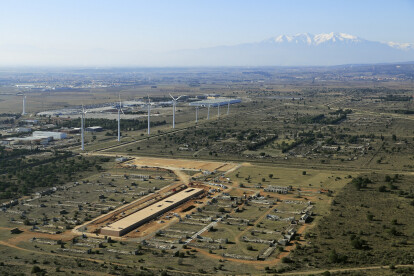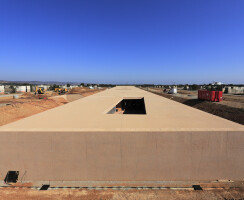A witness to some of the twentieth centuries darkest moments - the Spanish Civil War, World War II, the Algerian War of Independence - the Camp de Rivesaltes occupies a unique and important place in French history. A former military camp, a camp for Spanish refugees, the largest internement camp in Southern France in 1941 and 1942, an internement camp for German prisoners of war and collaborators, and the primary relocation centre for Harkis and their families… its history is unique.
In order to tell this story, a mémorial designed by architecte Rudy Ricciotti and the agency Passelac & Roques, opened its doors on 16 October 2015. Built on the former block F of the camp, in the middle of the existing buildings, the mémorial, measuring 4,000 m2, provides an authoritative account of the history of the forced displacement, and subjugation of populations. It is also a place where visitors may cultivate the memory of all those who once passed through its doors.
AN IMPORTANT PLACE OF REMEMBRANCE «A nation is strong when it has the courage to confront the worst facets of its his-tory. Bad things don’t just happen on the other side of the planet, they happened here. That this commemorative project may serve as a lesson to all of our youth, all of mankind.» Christian Bourquin.
In 1998, the Pyrénées-Orientales Departmental Council began a project to build a memorial on the site of the Camp de Rivesaltes and for this, acquired one of the blocks of the camp, block F (a 42-hec-tare site). Given the dimension of the project, the Languedoc-Roussillon Region then emerged as the most suitable actor to ensure the successful realization of the project. The latter has overseen the management of the memorial project since January 2012. Languedoc-Roussillon is the first region in France to undertake a memorial project of this scale and scope, with the aim of promoting a greater awareness of our past and providing the tools to understand a shared history.The history of the Camp de Rivesaltes is at the pivot of events (the Spanish Civil War, World War II, the Holocaust, the Algerian War of Independence, etc.), countries (Spain, Germany, Italy, Belgium, France, Poland, USA, Israel, Algeria, etc.), and cultures. It is also the only site where visible traces of an entire part of the history of the second half of the twentieth century can be seen. This makes the site unique in France. The memorial will become a reference place for the history of the forced displacement of populations and their subjugation, but also a joint place of remembrance.Memories, repressed or sublimated, the cornerstone of communal identities, are the subject of teaching and research, key elements of a historical narrative that aims to explain, set out the facts and allow, through a multidimensional approach, a common narrative to be passed down to present and future generations. The memorial therefore has a deeply humanistic vocation: its intention is to allow communities, unaware of their respective histories, to discover them all under the one roof. The questions of memory, transmission and education are the foundations of the Rivesaltes Memorial. This site, with regional, national and international dimensions has a variety of missions: • historical research, the restitution and transmission of this knowledge to the general public, through the form of exhibitions, publications, seminars, conferences, etc. • an educational dimension with the aim of promoting awareness and knowledge and encouraging a questioning on specific themes, namely the relationship between history and memory, through guided tours, workshops, educational resources, etc. • an artistic and cultural programme that allows the public to question history and memory in a sensitive and alternative fashion, through the form of exhibitions, artist residencies, concerts, film screenings, etc. The permanent exhibit takes visitors on a discovery of the memorial and of its history. Visitors can also follow an open-air path through the camp, amidst the remains of the barracks. Some of the former buildings have been left untouched, while others have been restored or reconstructed. Combining history and memory, eye-witness accounts and historical records, the aim of the permanent exhibition is to reconstruct the history of the site and the populations once interned there, to explain the causes and mechanisms of their internment, and to shed light on their living conditions and their fate.
THE HISTORY OF THE PROJECT The project of the Mémorial du Camp de Rivesaltes has a long history, punctuated rather unsurprisingly by the vagaries of politics, given that history, politics and memory are so closely intertwined. Firstly, it is worth noting that this project was born from civilian society. Three individuals played a decisive role in the origin of the project: Claude Delmas and Claude Vauchez, who were instrumental in getting the local authorities on board with the project, and Serge Klarsfeld who worked on a national level. It all began in the mid 1990s, with the publication of the Journal de Rivesaltes 1941-1942 (Diary of Rive-saltes), published in 1993. This diary was written by Friedel Bohny-Reiter, a nurse working with a Swiss relief organization for children. In her journal, she writes about life in the camp and the drama of deportation. In 1994, a monument was erected in memory of Jews deported from the Camp de Rivesaltes to Auschwitz, with another monument being erected in December 1995 in honour of the Harkis. This was followed by another commemorative monument in 1999, in homage to the Spanish Republicans. However, it was the scandal caused by the discovery of a file from the camp in a dump by journalist Joël Mettray that marked a milestone in the history of the project. In the wake of this discovery, a large-scale national petition was launched by Claude Delmas and Claude Vauchez, and was signed by well-known figures like Claude Simon, Simone Veil and Edgar Morin. It was at this time that the project took on a political dimension through the involvement of Christian Bourquin, a Socialist candidate running for presidency of the département of the Pyrénées-Orientales, a position he would win in 1998. Throughout his career, as President of the Departmental Council, and later as President of the Regional Council—succeeding Georges Frèche—he made the memorial project one of his priorities. In 2000, Block F was identified by heritage organization, Monuments Historiques, as worthy of conserva-tion. Soon, everything began to fall into place. Chris-tian Bourquin asked Denis Peschanski, a historian specializing in France’s internment camps, to create and chair a scientific and research council which would provide a historical framework to the project. A memorial commission was also established, bringing together various associations, as well as an education commission made up of teachers who had been working on themes relating to the memorial and its history with students for a number of years. Finally, in January 2006, architect Rudy Ricciotti, in collaboration with the architecture agency Passe-lac & Roques, was awarded the overall design of the project. The project to develop a memorial received unanimous support in a vote by the Pyrénées-Orientales Departmental Council. Robert Badinter would then bring his moral support by agreeing to sponsor the project. There followed a long period of planning and development. While political issues slowed down the advancement of the project, this time was used to learn more about the history of the camp. A photographic inventory was performed on the three ma-jor blocks of the camp, J, F and K. Things finally began to move quickly in 2010 when the building permit was issued, with construction work finally beginning in 2012. In 2013, an endowment fund was created, presided by Anne Lauvergeon, and charged with sourcing and mobilizing private financial aid. In January 2014, the memorial’s administrative framework was put in place (EPCC) and its direction entrusted to Agnès Sajaloli, the following month. Sadly, Christian Bourquin passed away on the 26 August 2014 before witnessing the completion of this project and the inauguration of the Rivesaltes Memorial. History will remember that it was at his funeral, in a speech delivered by Prime Minister Manuel Valls that the French government declared its moral and financial commitment to the project, alongside support from the Languedoc-Roussillon Region and the Departement of the Pyrénées-Orientales. On 16 October 2015, French Prime Minister Manuel Valls, officially inaugurated the Mémorial du Camp de Rivesaltes.






























